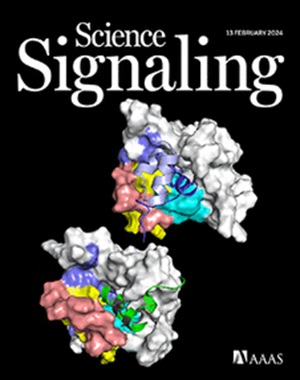压力下的周细胞:TRPC3通道作为毛细血管流动的看门人
IF 6.6
1区 生物学
Q1 BIOCHEMISTRY & MOLECULAR BIOLOGY
引用次数: 0
摘要
脑血流响应血管内压力的内在控制传统上归因于小动脉中的平滑肌细胞。然而,在本期《Science Signaling》中,Ferris等人证明毛细血管收缩是由包围毛细血管的周细胞(壁细胞)的压力诱导去极化引起的,并由TRPC3阳离子通道介导,确定该通道对微调脑灌注至关重要。本文章由计算机程序翻译,如有差异,请以英文原文为准。
Pericytes under pressure: TRPC3 channels as gatekeepers of capillary flow
Intrinsic control of cerebral blood flow in response to intravascular pressure is traditionally attributed to smooth muscle cells in arterioles. However, in this issue of Science Signaling, Ferris et al. demonstrate that capillary constriction is caused by pressure-induced depolarization of pericytes, mural cells that encircle capillaries, and is mediated by TRPC3 cation channels, identifying the channel as critical for fine-tuning brain perfusion.
求助全文
通过发布文献求助,成功后即可免费获取论文全文。
去求助
来源期刊

Science Signaling
BIOCHEMISTRY & MOLECULAR BIOLOGY-CELL BIOLOGY
CiteScore
9.50
自引率
0.00%
发文量
148
审稿时长
3-8 weeks
期刊介绍:
"Science Signaling" is a reputable, peer-reviewed journal dedicated to the exploration of cell communication mechanisms, offering a comprehensive view of the intricate processes that govern cellular regulation. This journal, published weekly online by the American Association for the Advancement of Science (AAAS), is a go-to resource for the latest research in cell signaling and its various facets.
The journal's scope encompasses a broad range of topics, including the study of signaling networks, synthetic biology, systems biology, and the application of these findings in drug discovery. It also delves into the computational and modeling aspects of regulatory pathways, providing insights into how cells communicate and respond to their environment.
In addition to publishing full-length articles that report on groundbreaking research, "Science Signaling" also features reviews that synthesize current knowledge in the field, focus articles that highlight specific areas of interest, and editor-written highlights that draw attention to particularly significant studies. This mix of content ensures that the journal serves as a valuable resource for both researchers and professionals looking to stay abreast of the latest advancements in cell communication science.
 求助内容:
求助内容: 应助结果提醒方式:
应助结果提醒方式:


